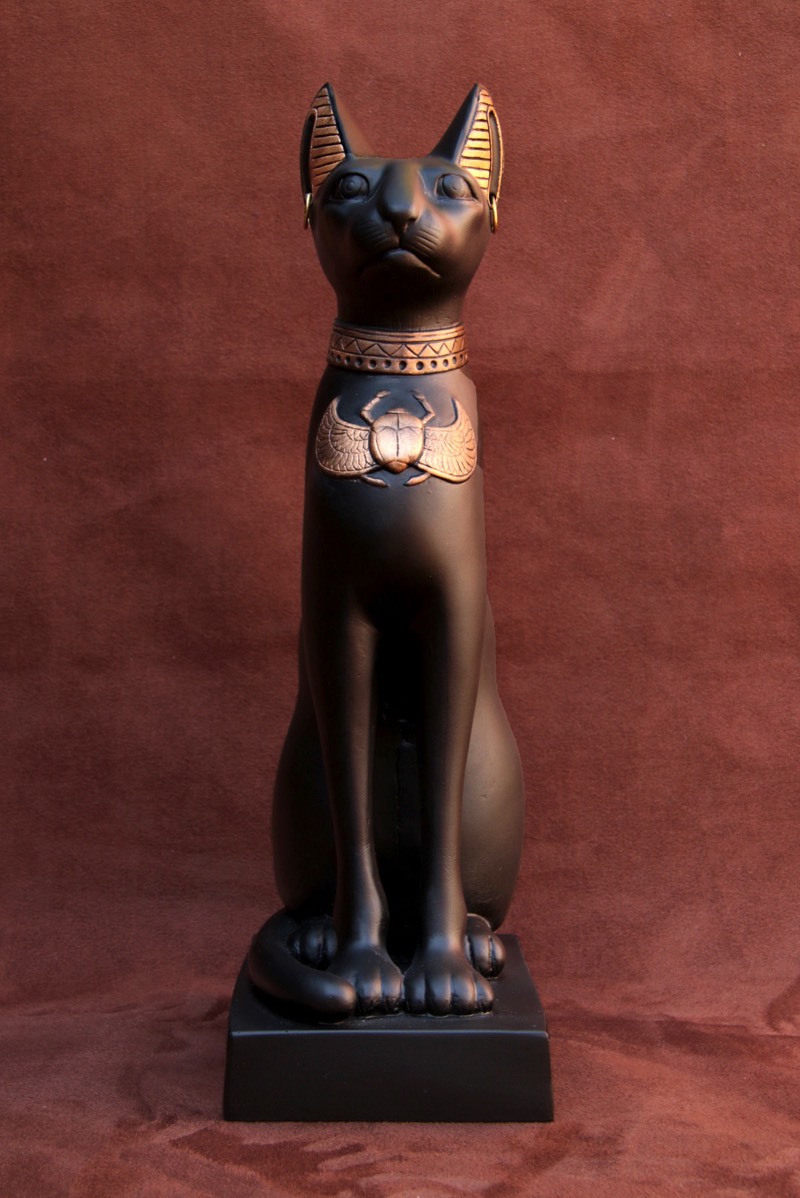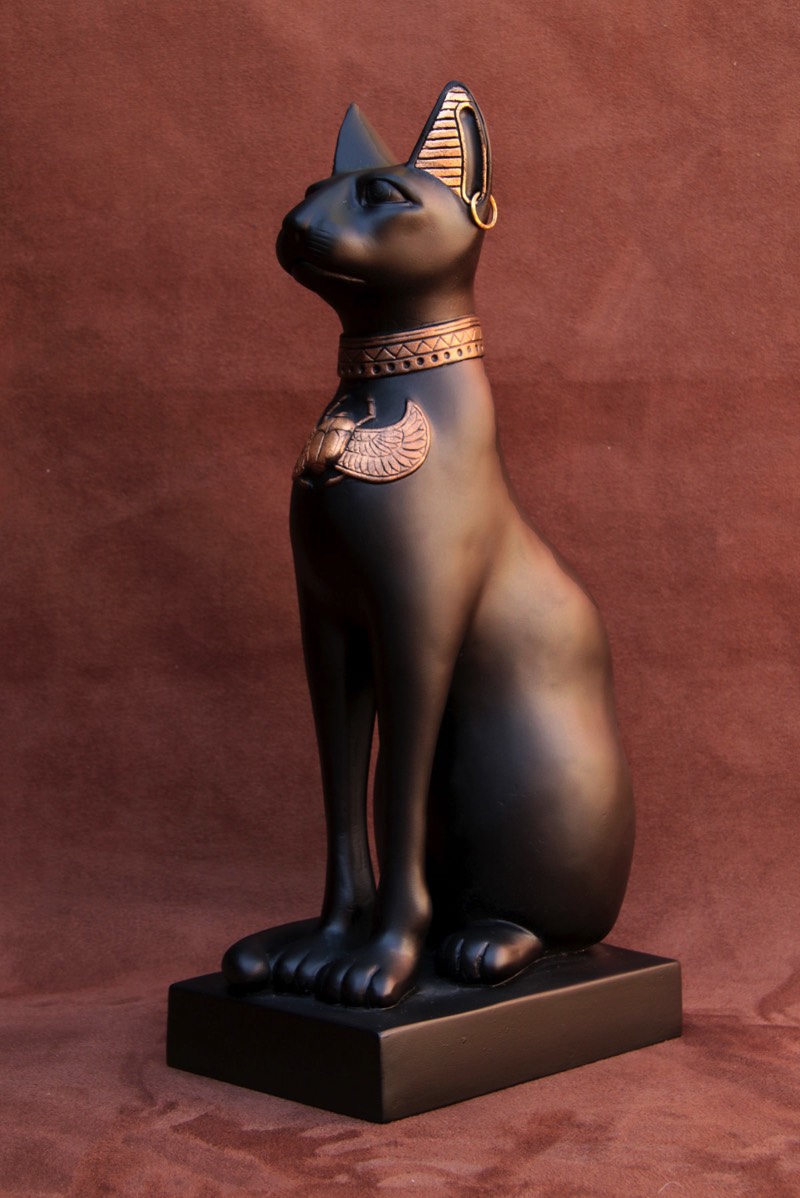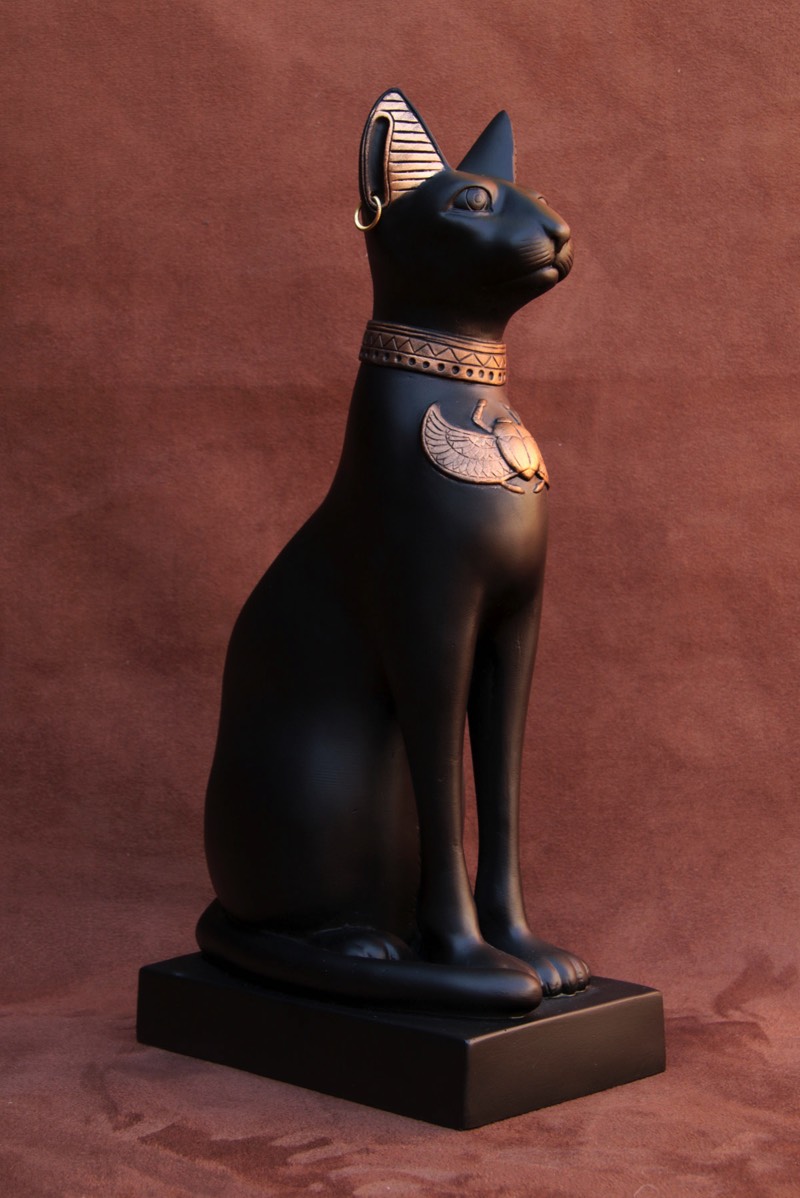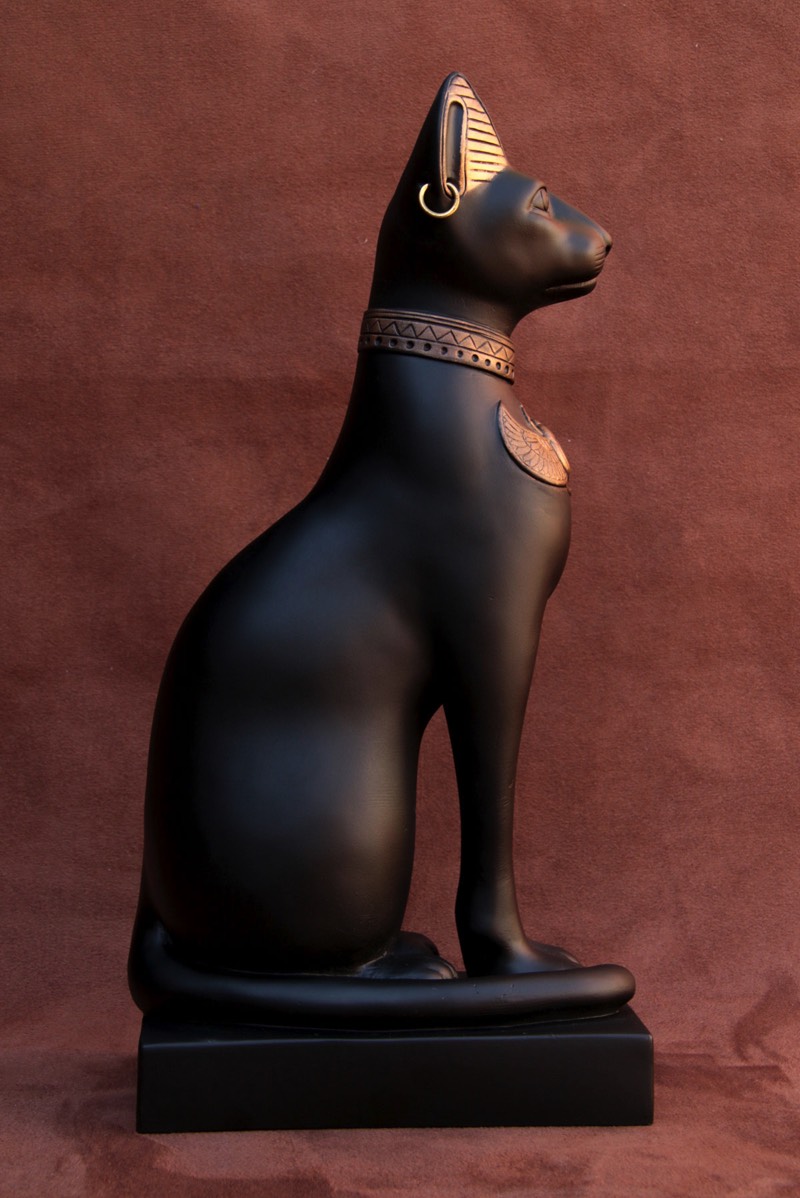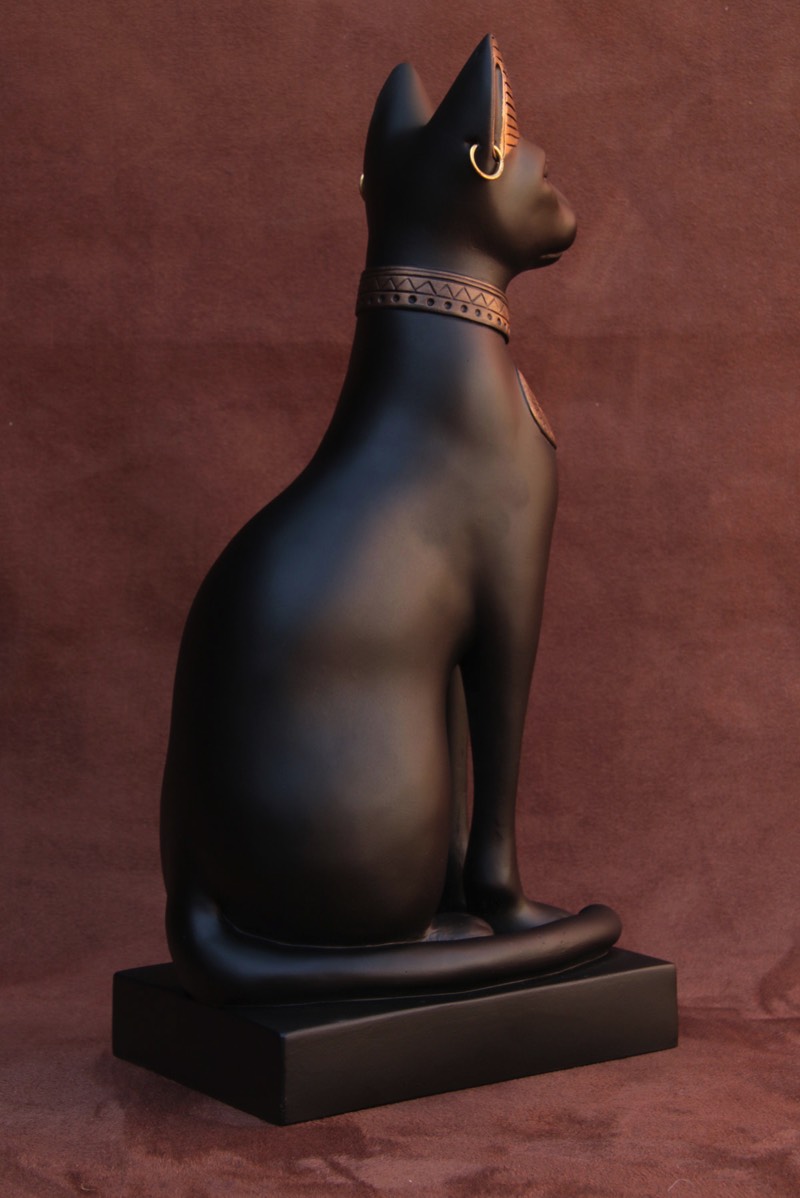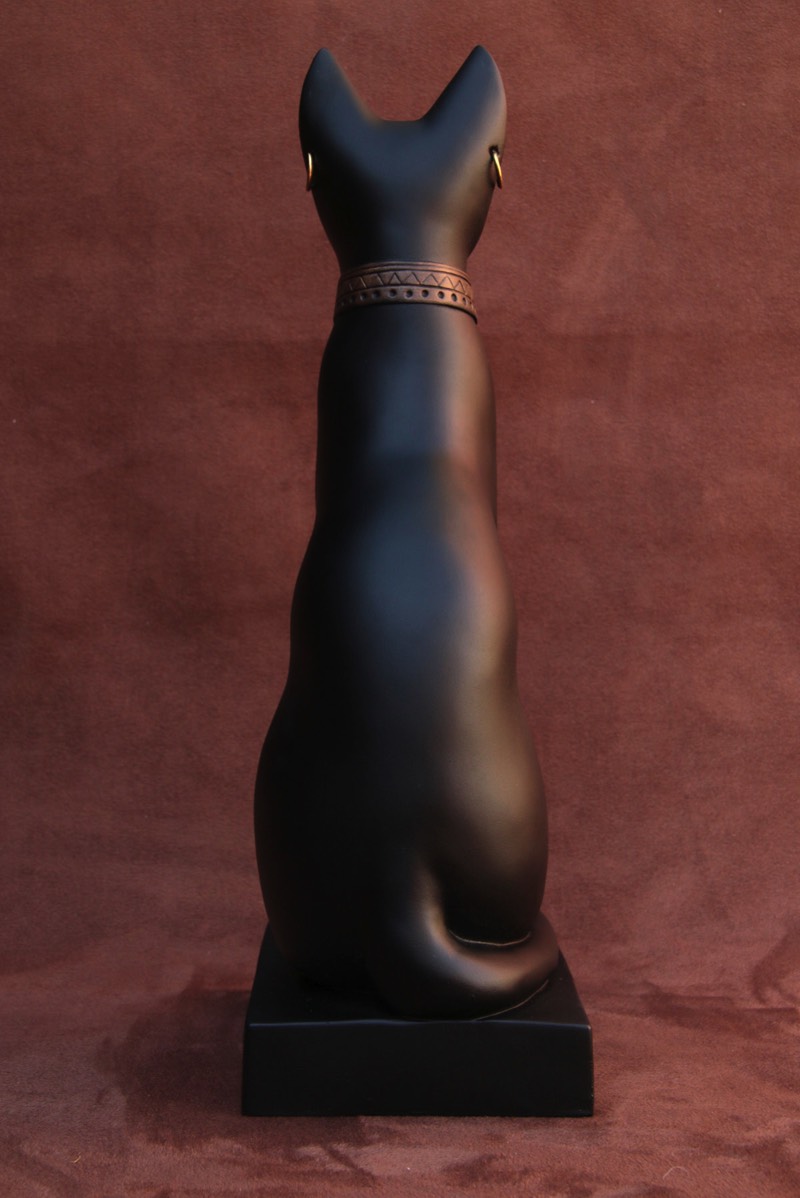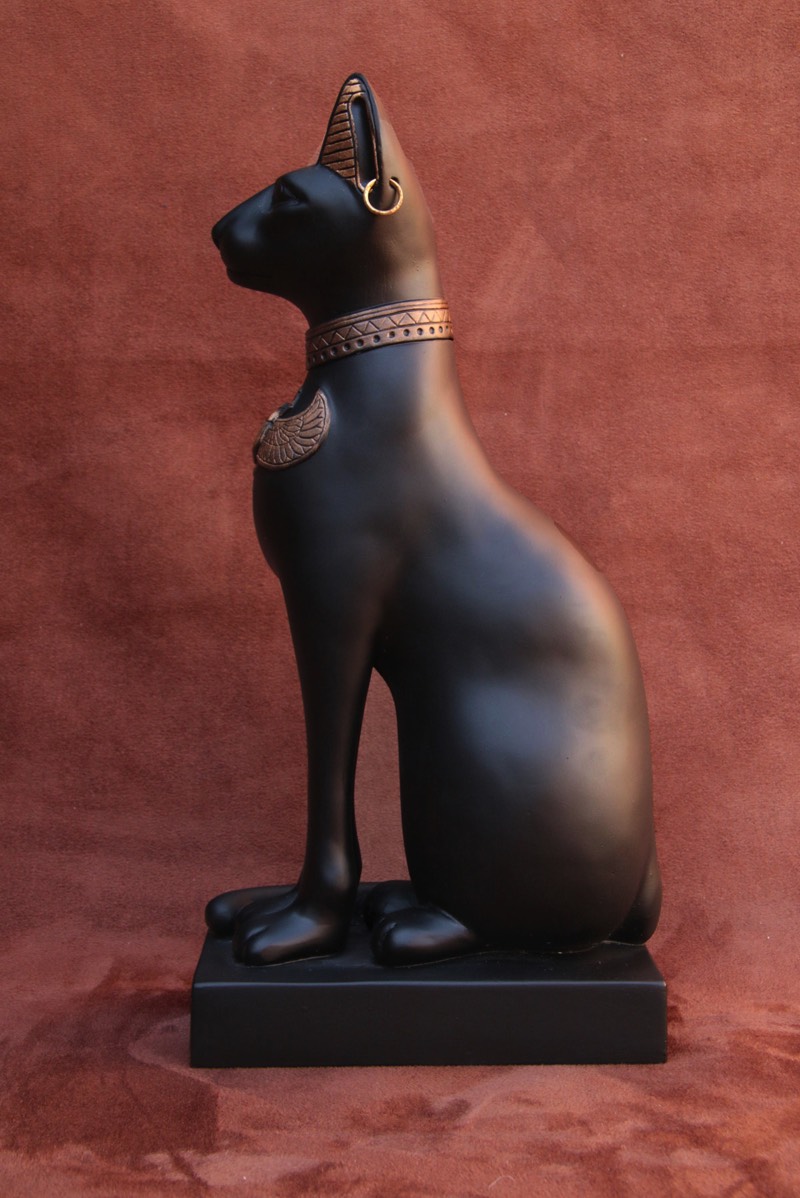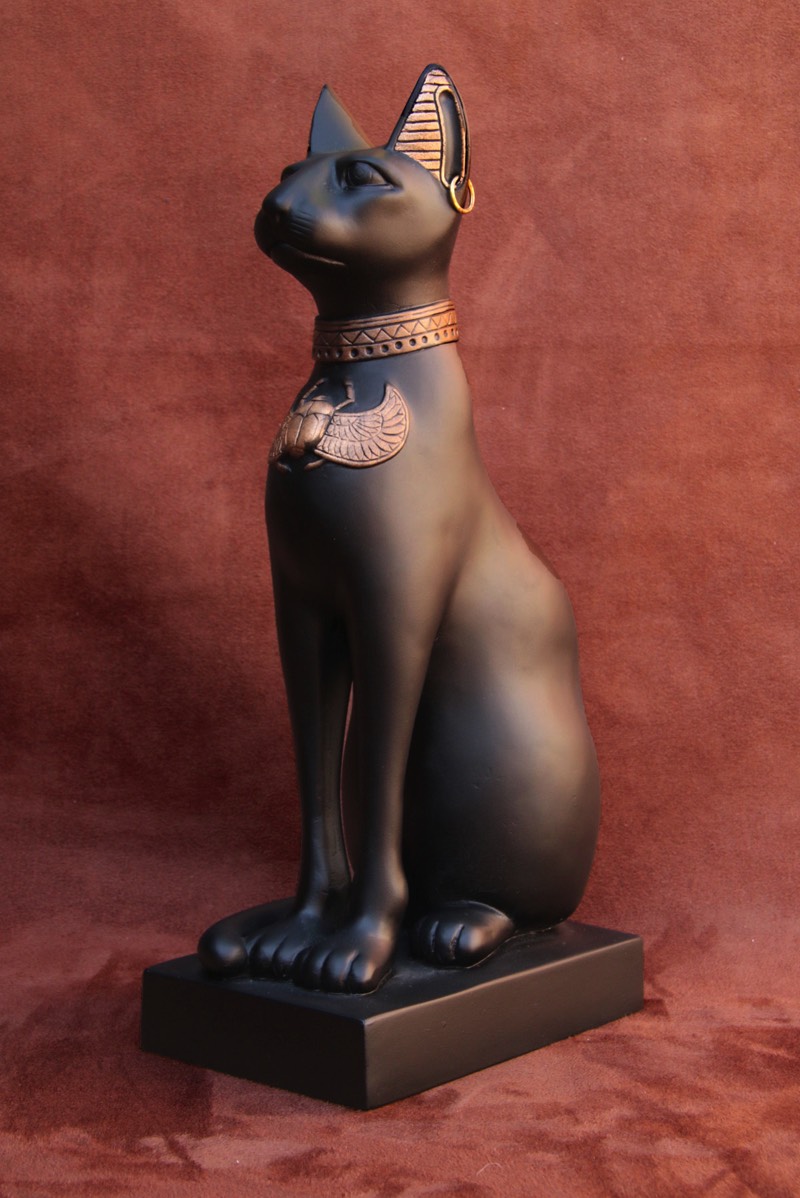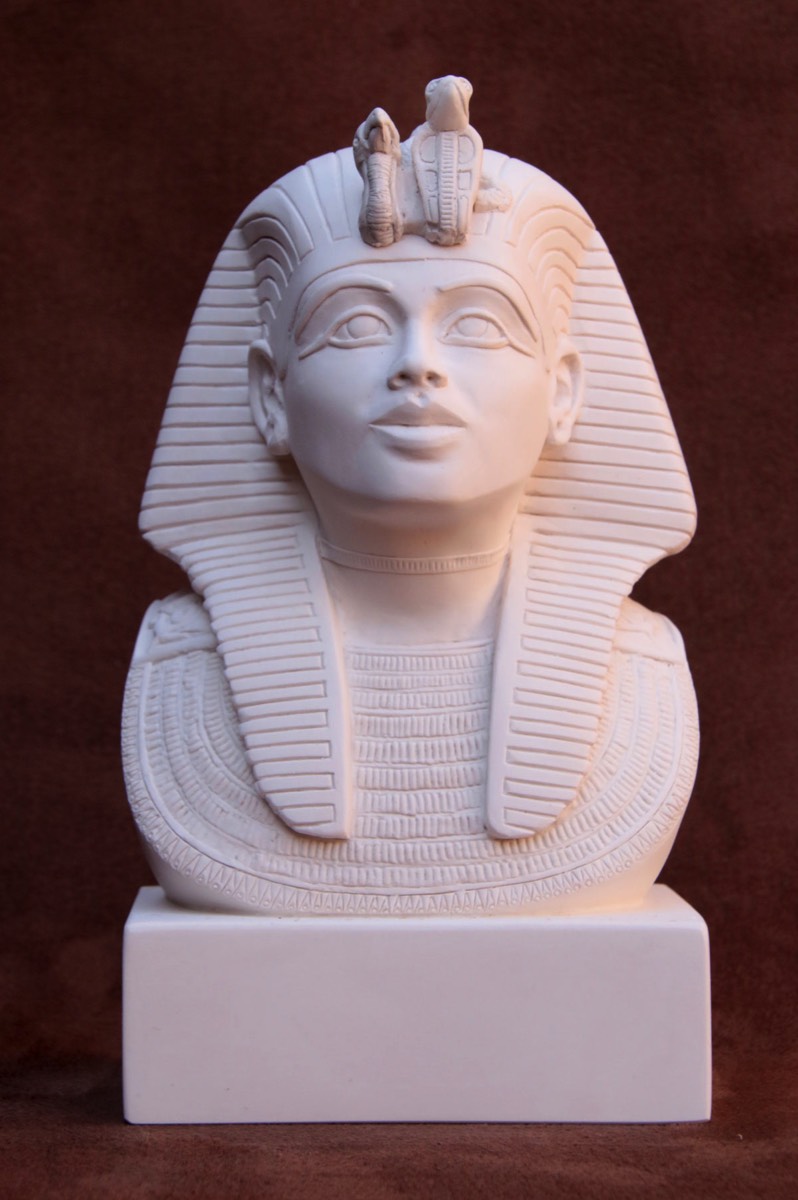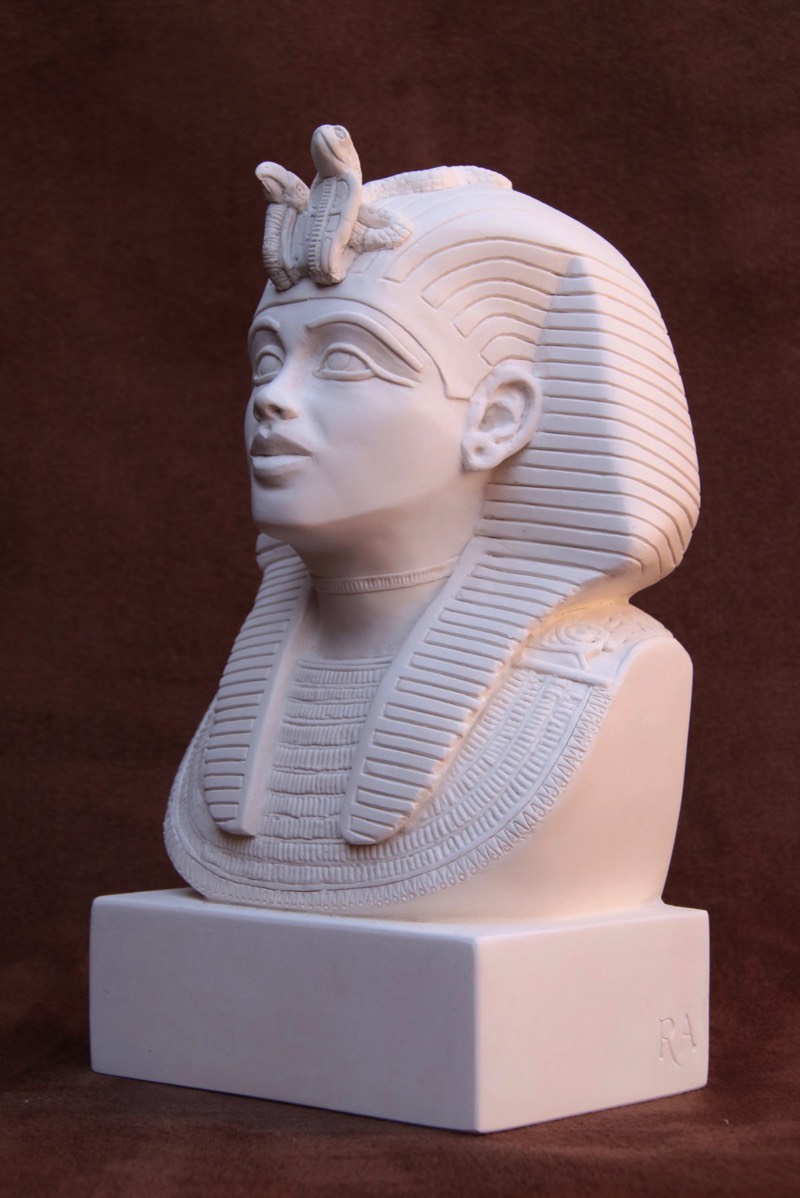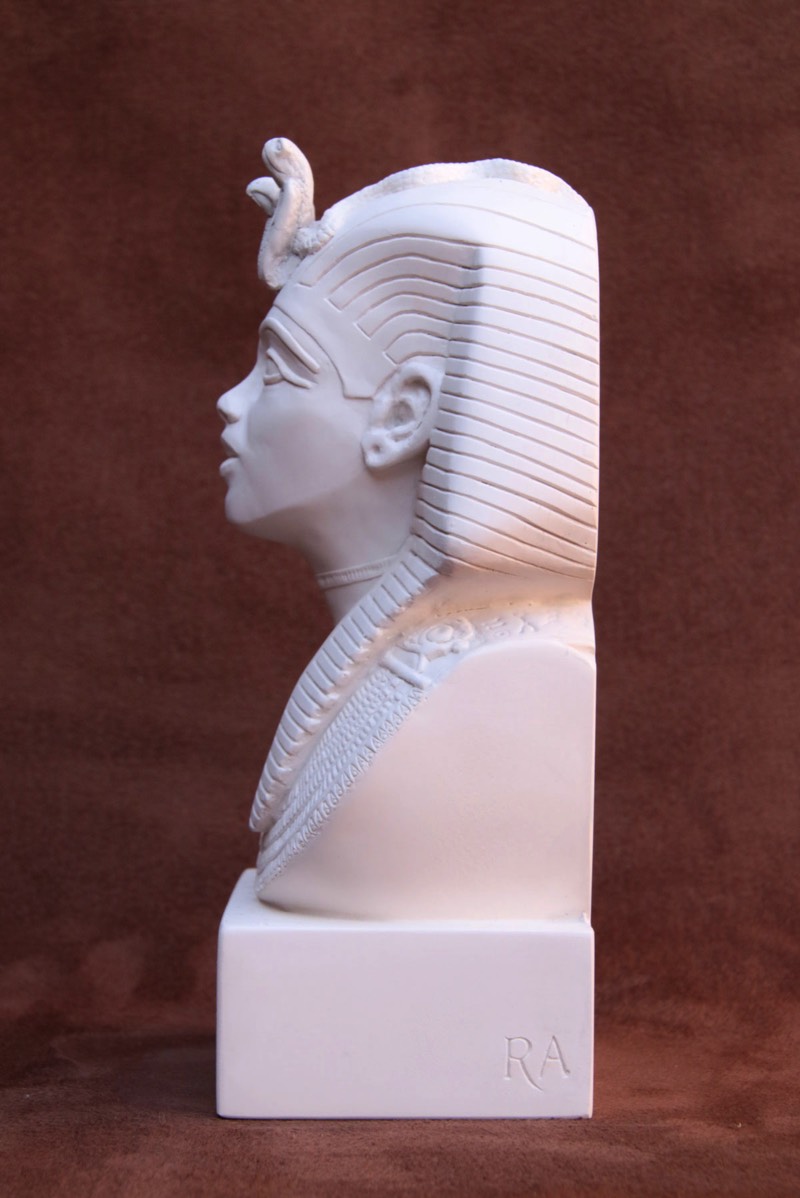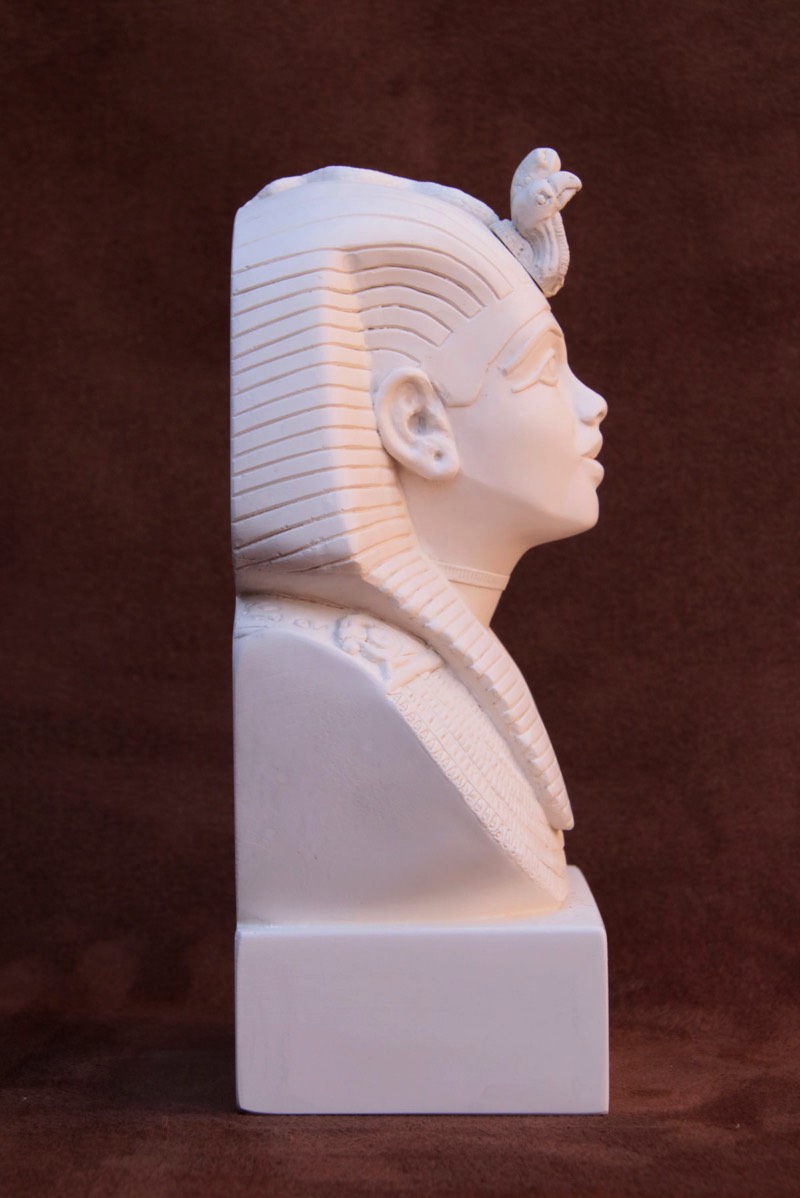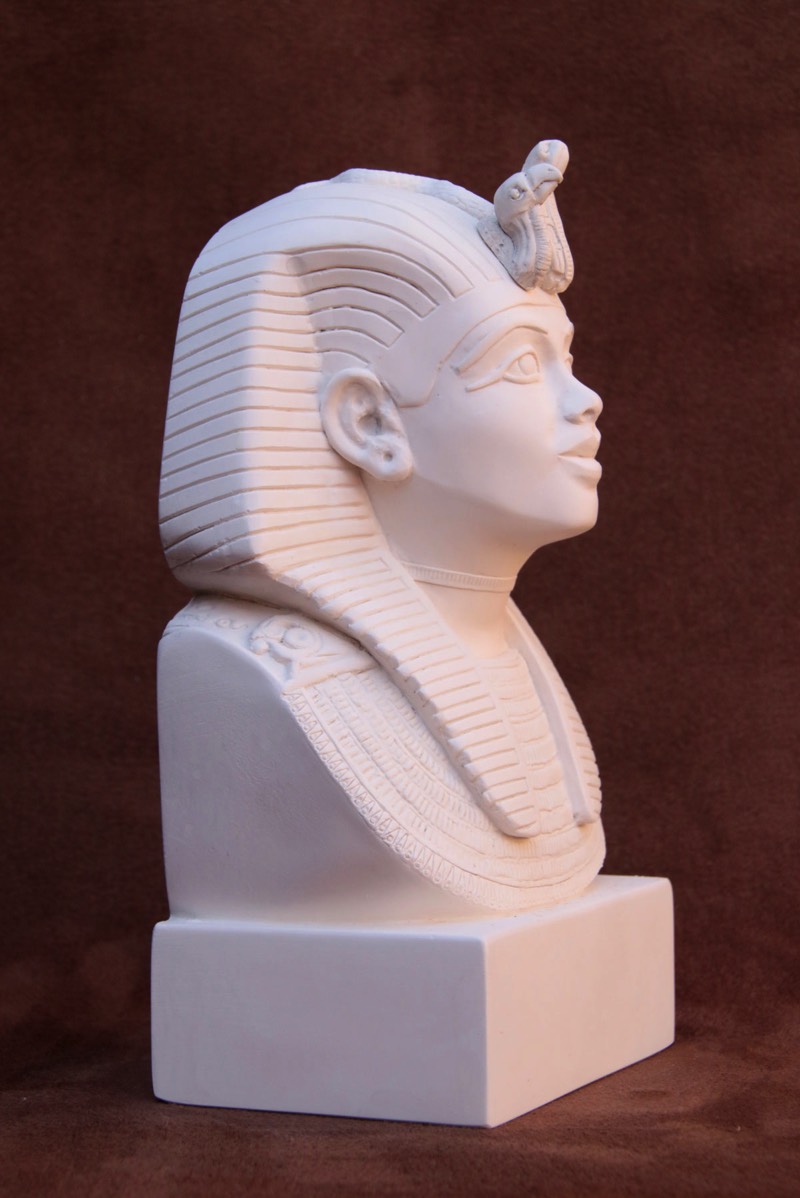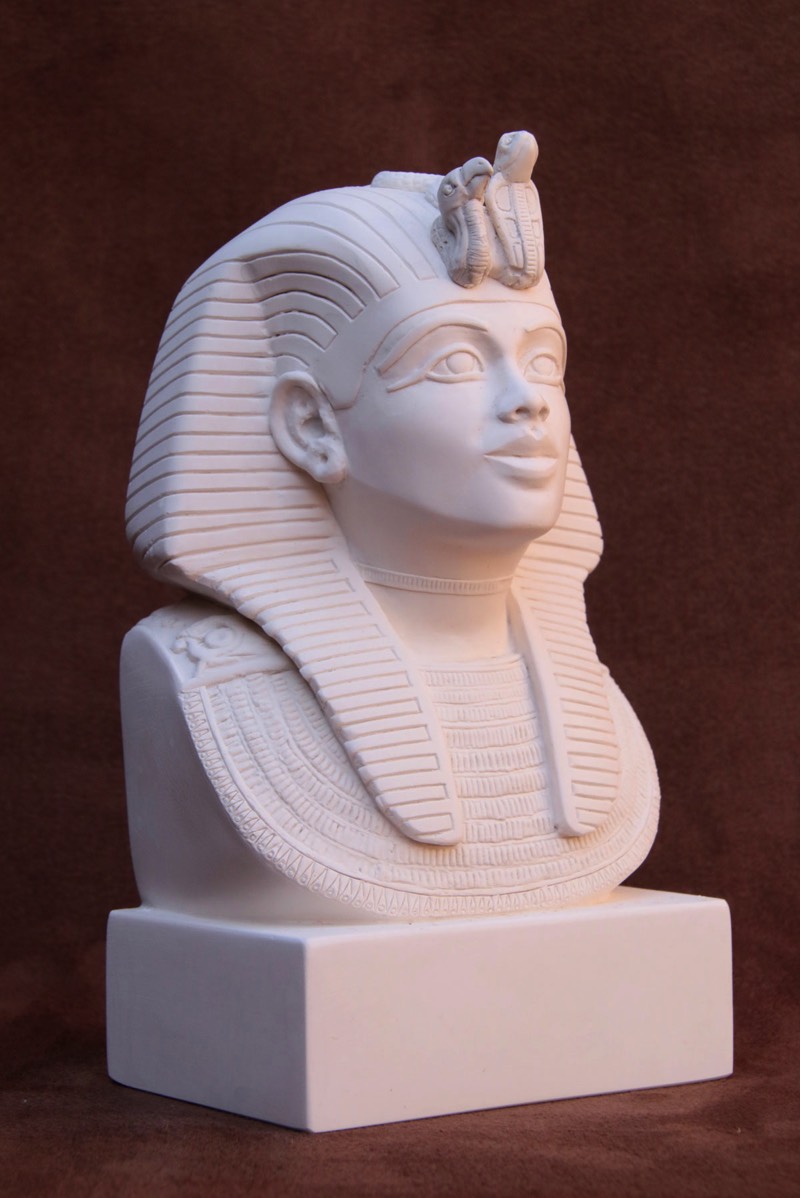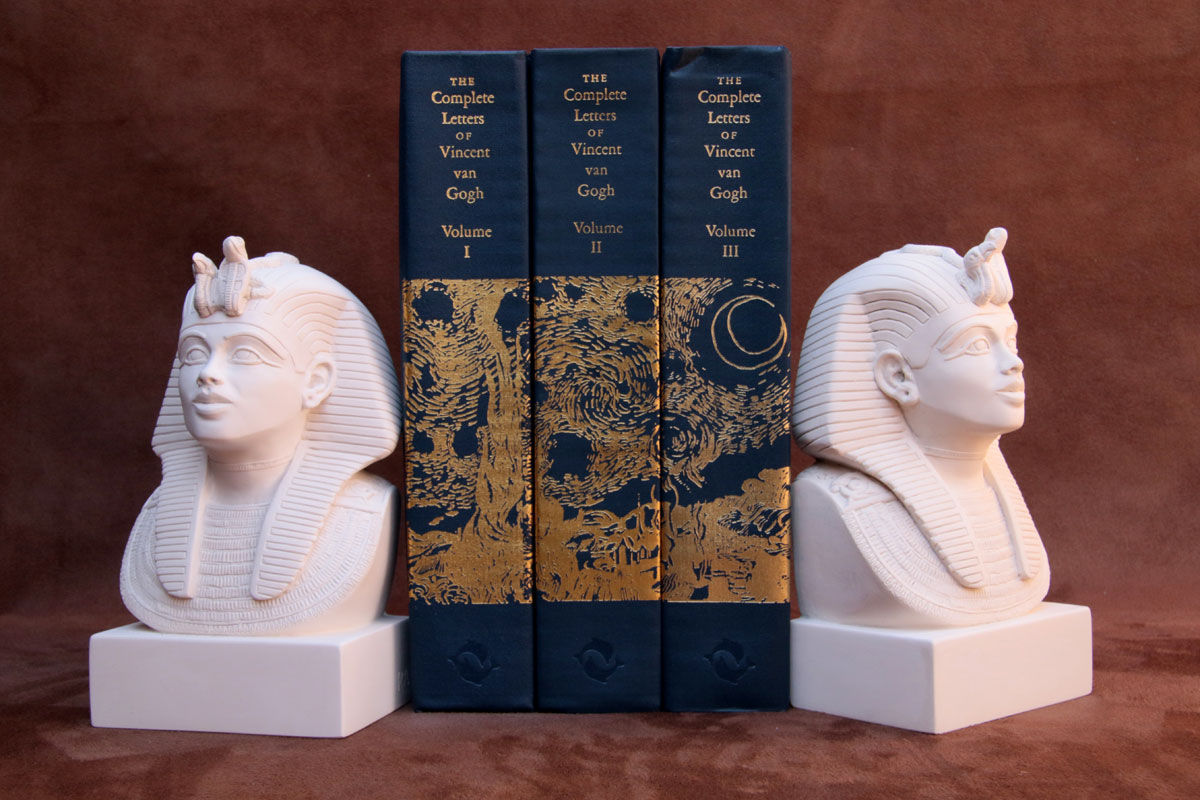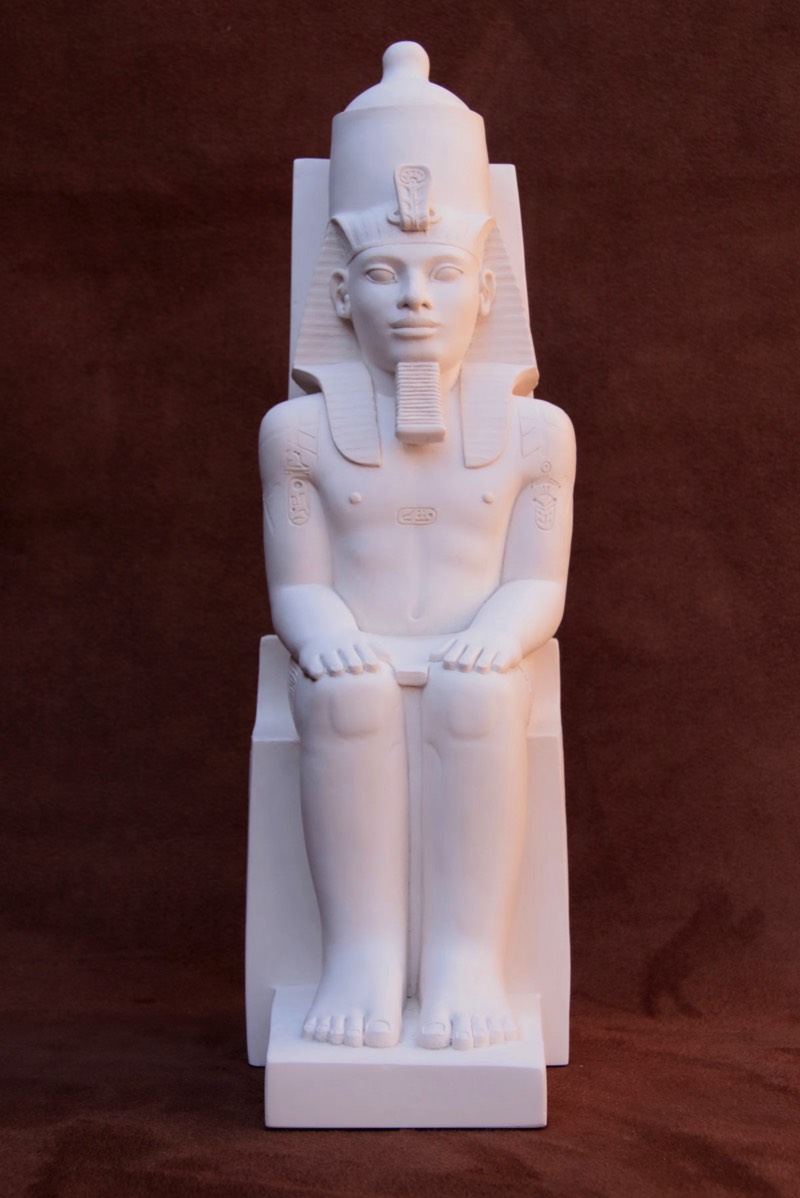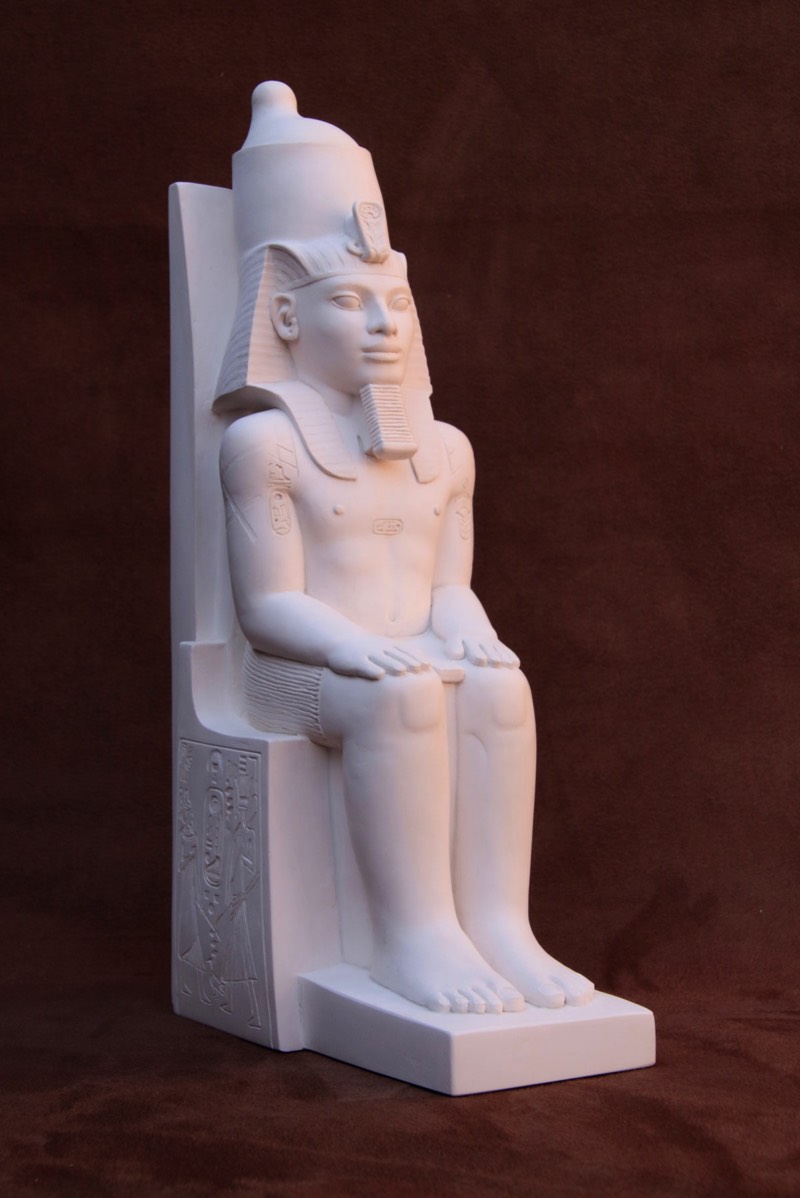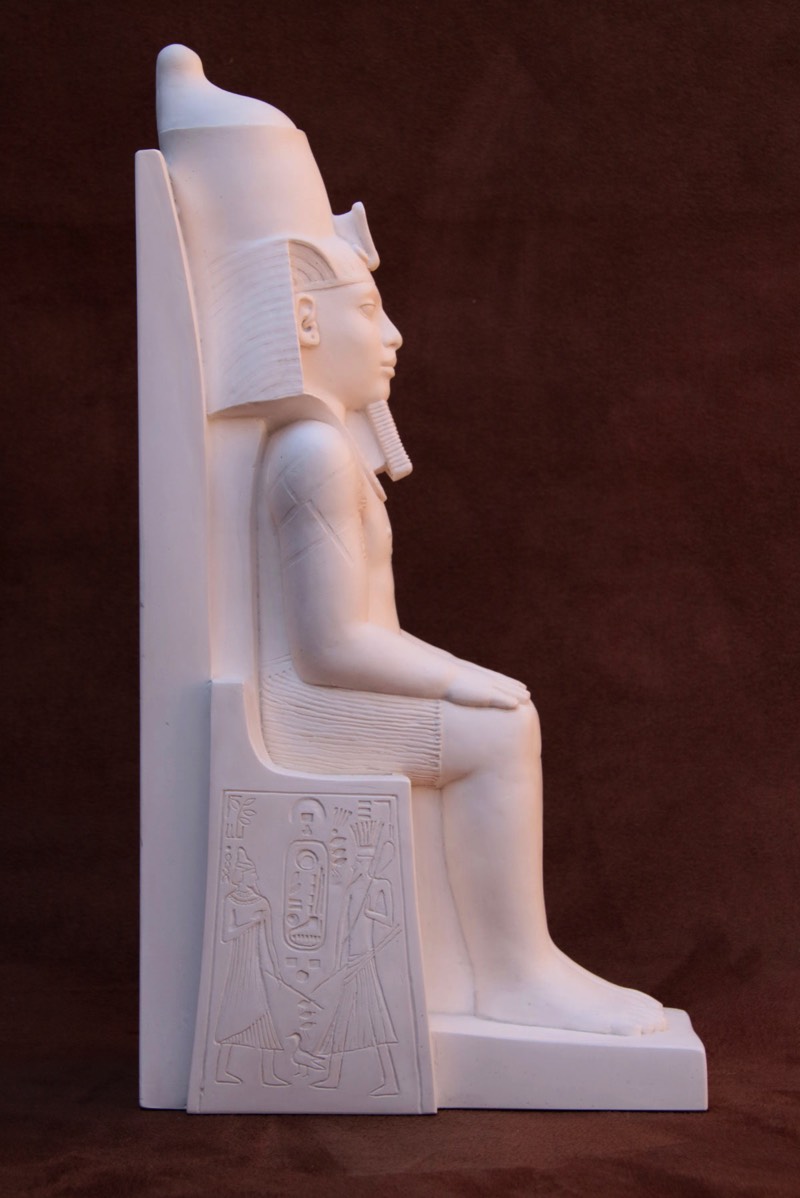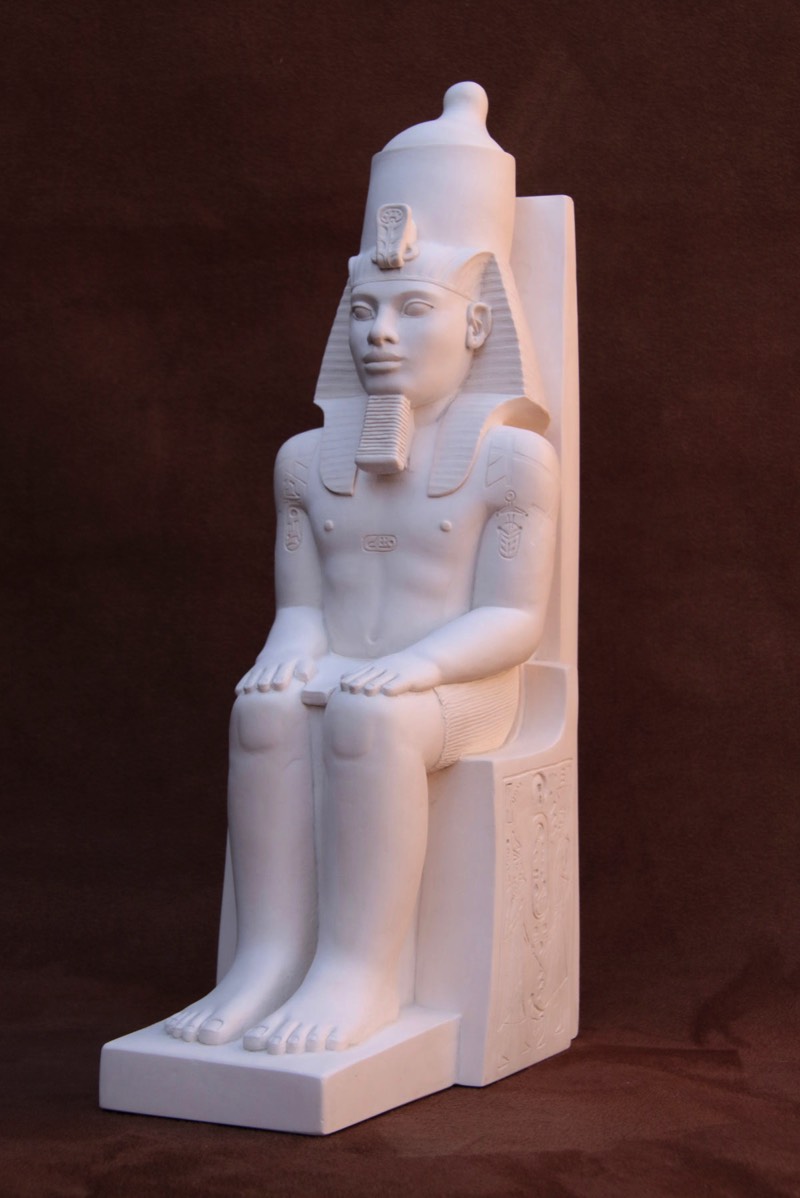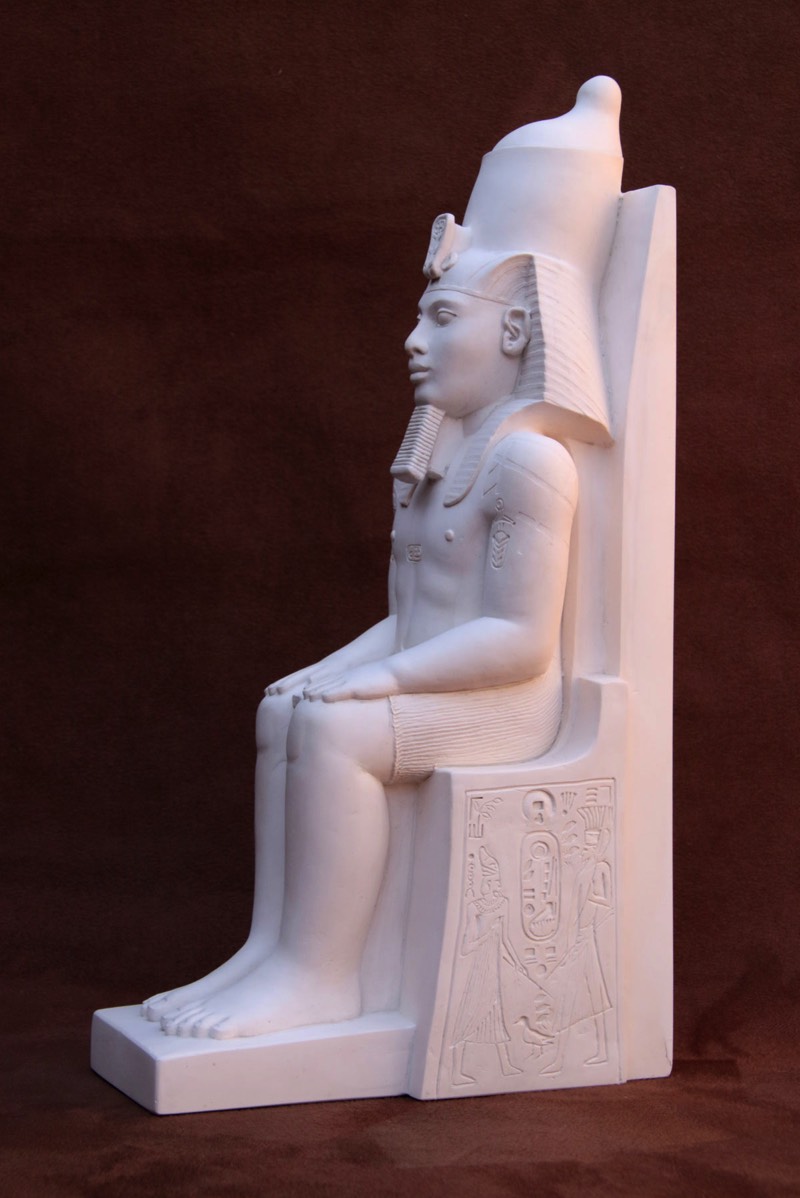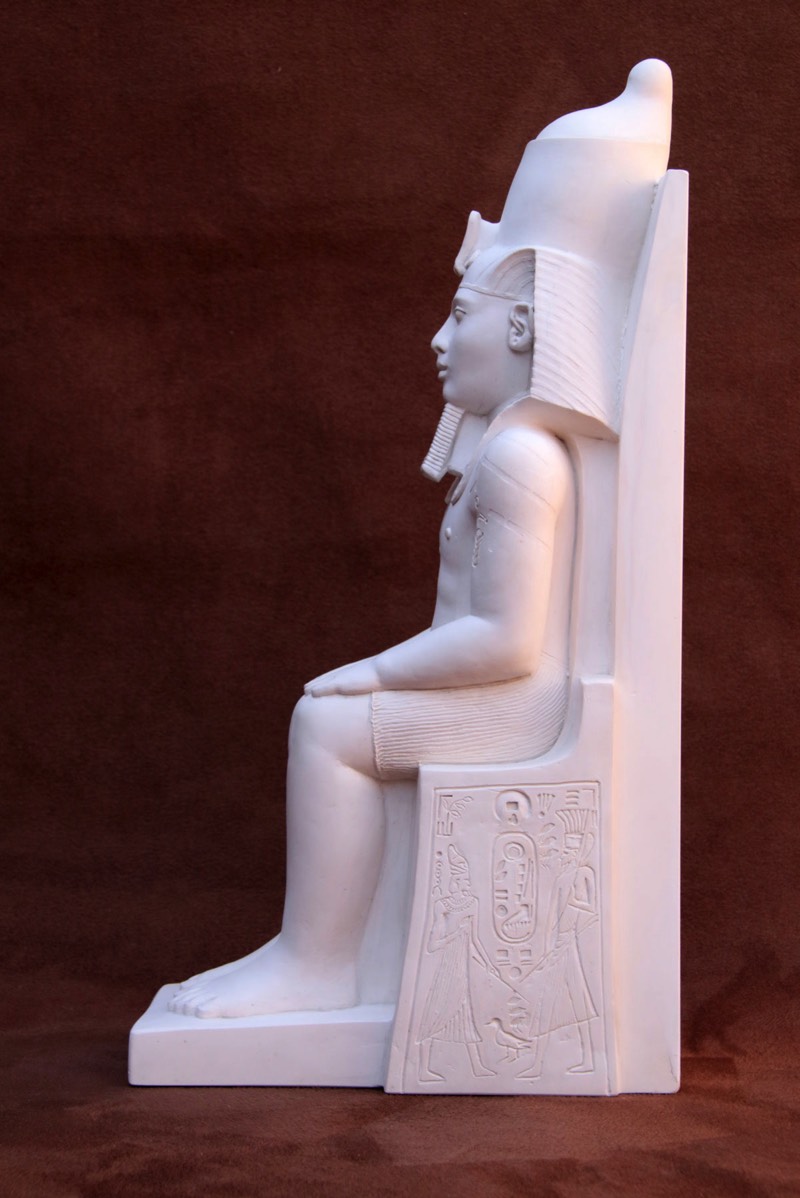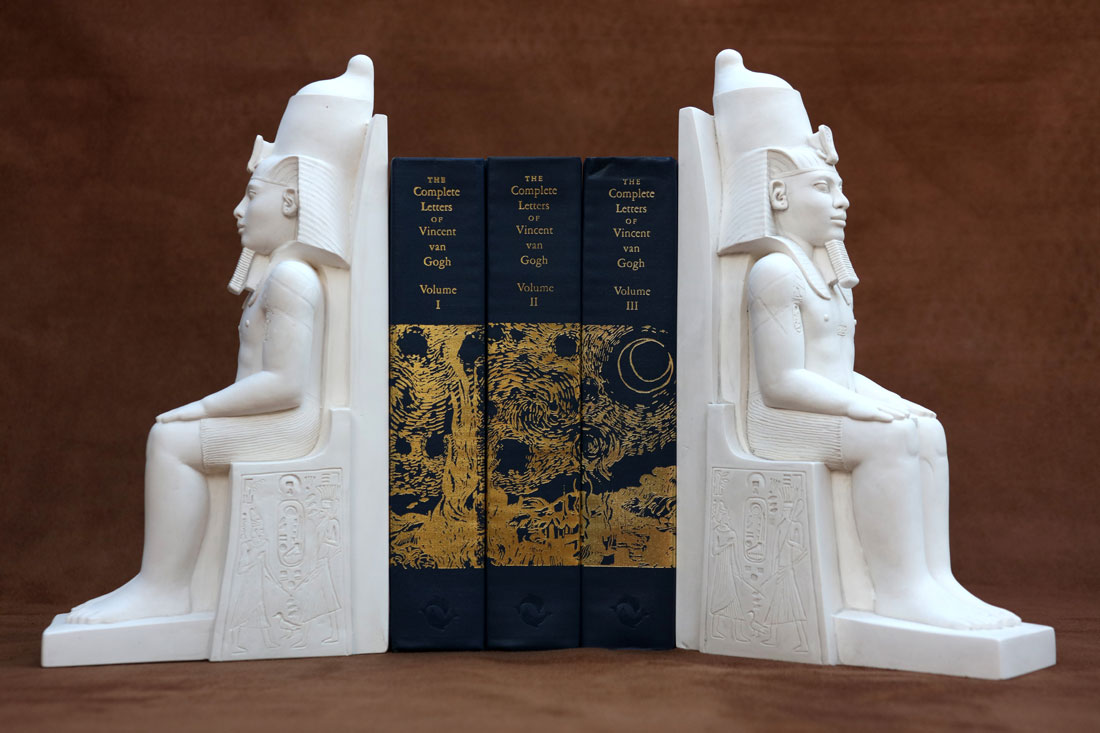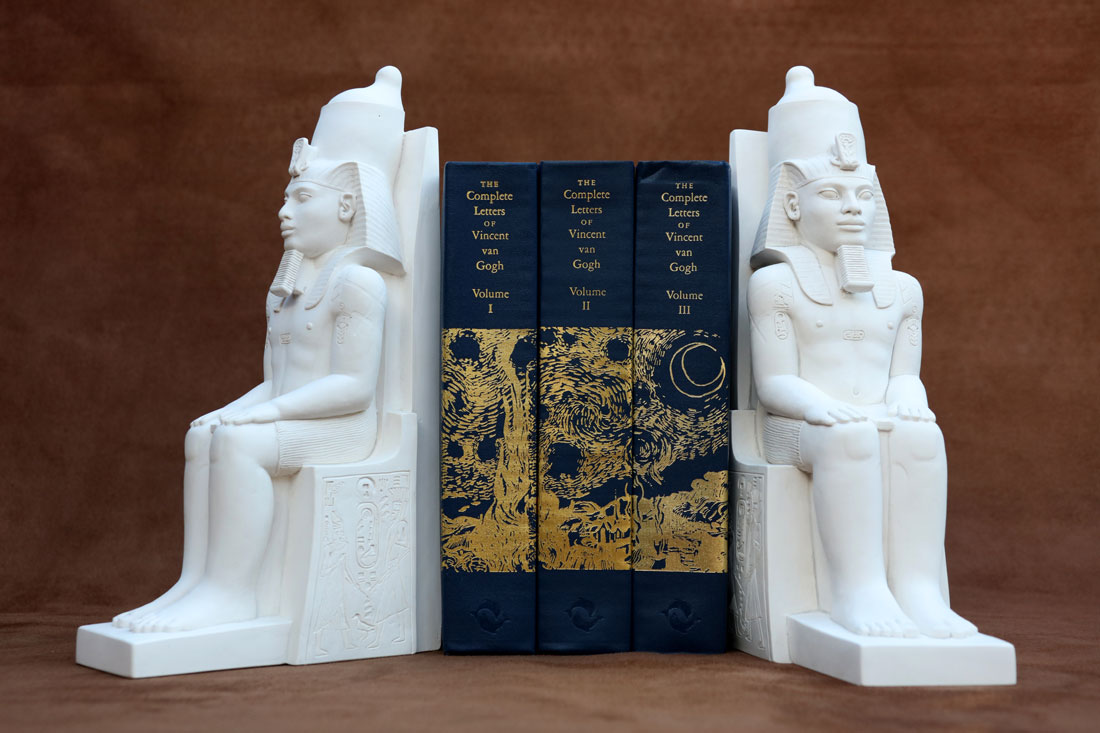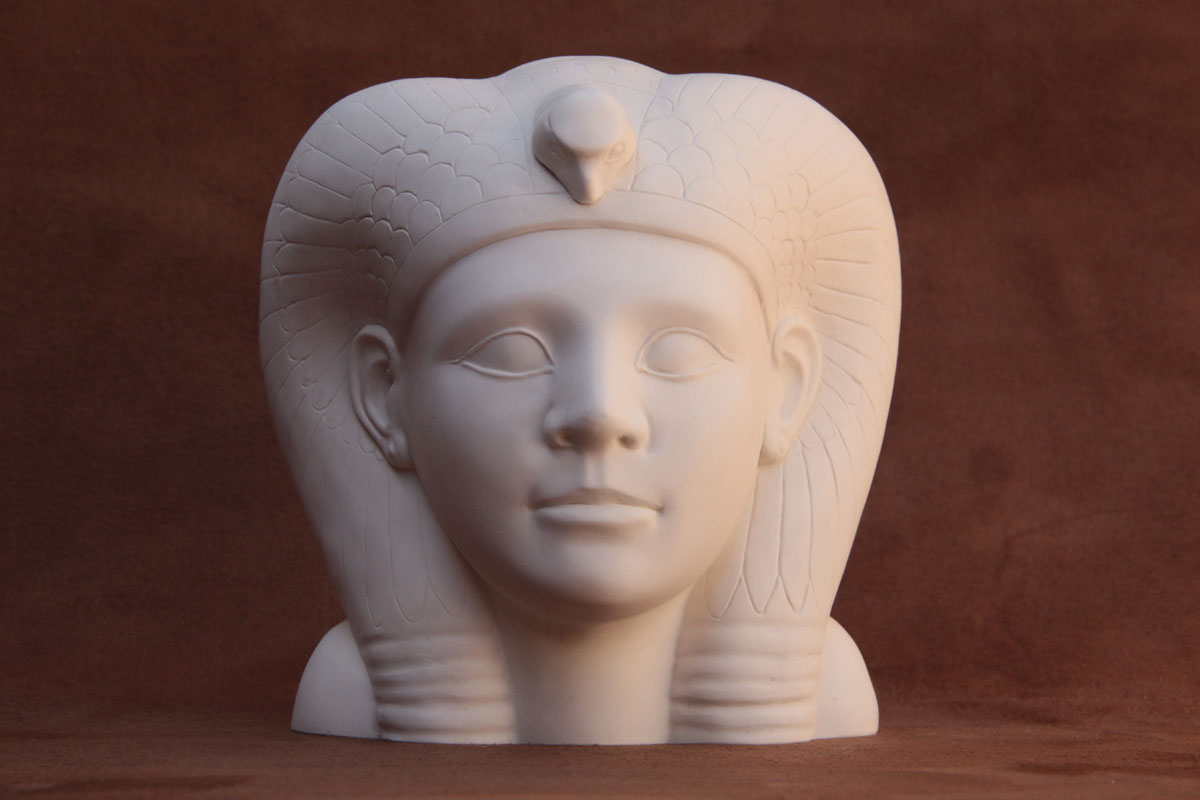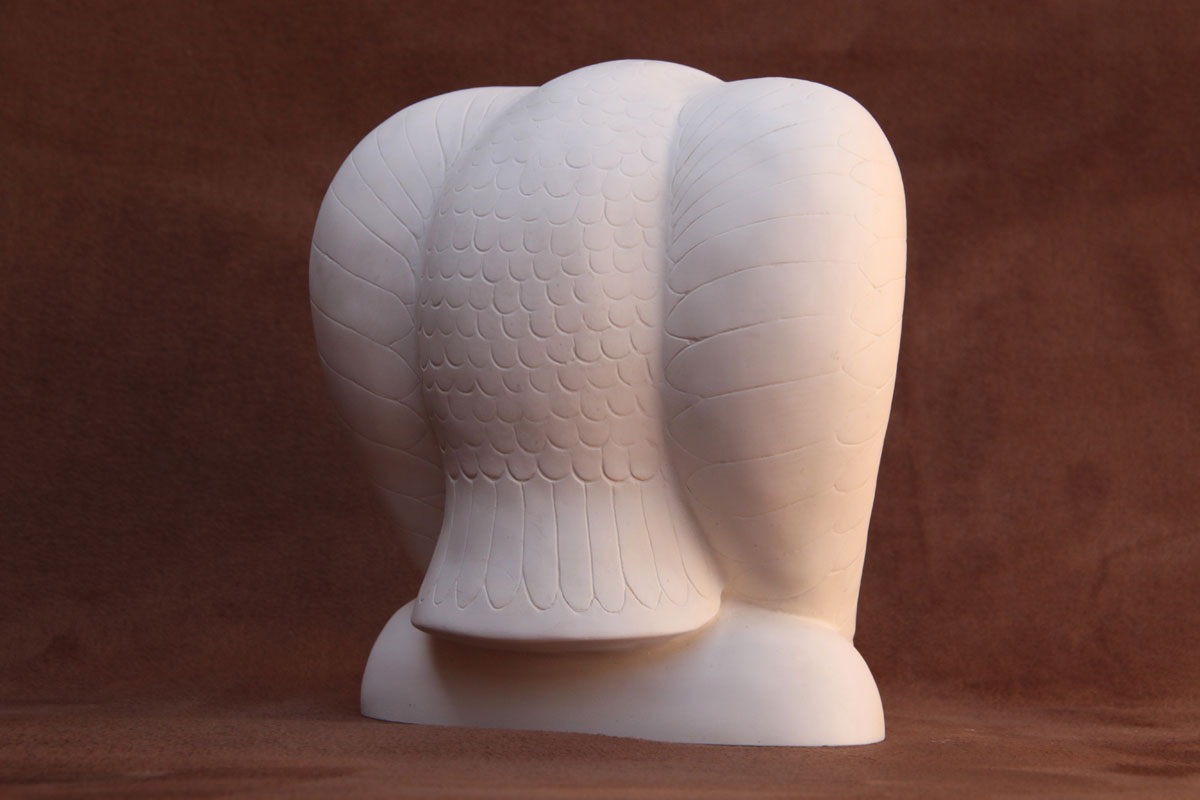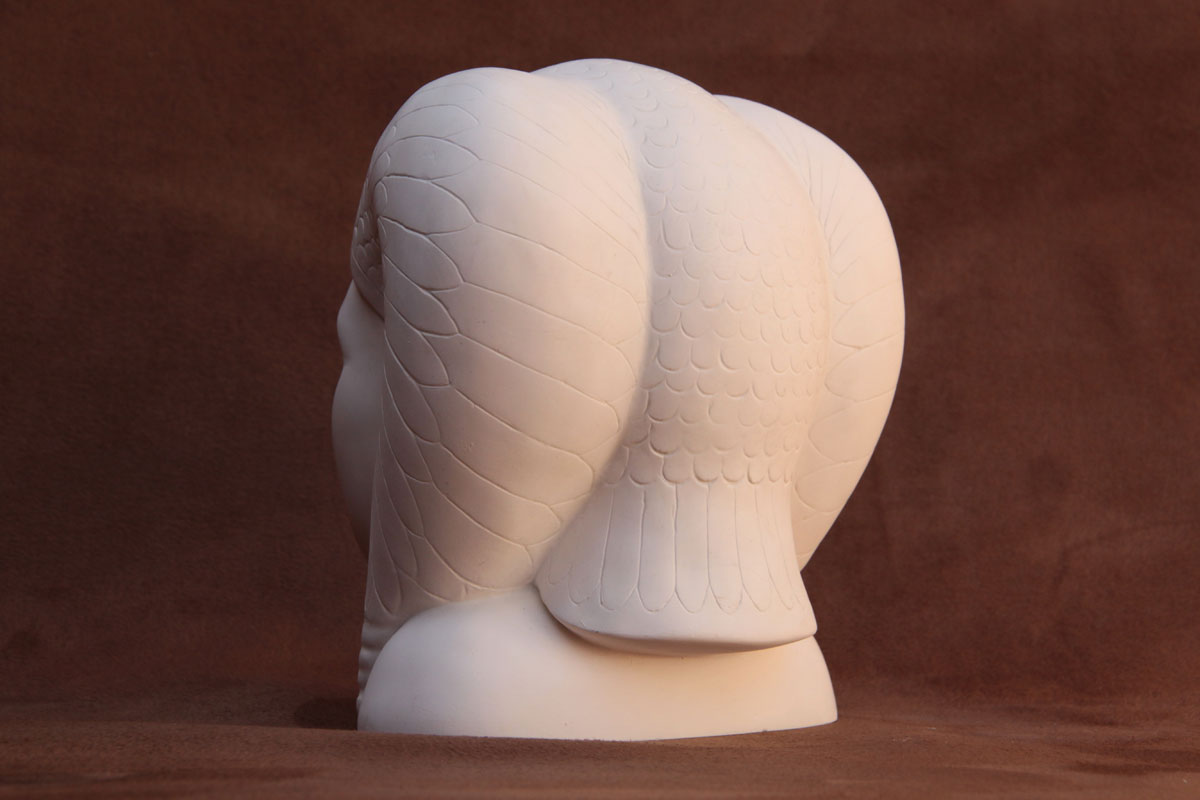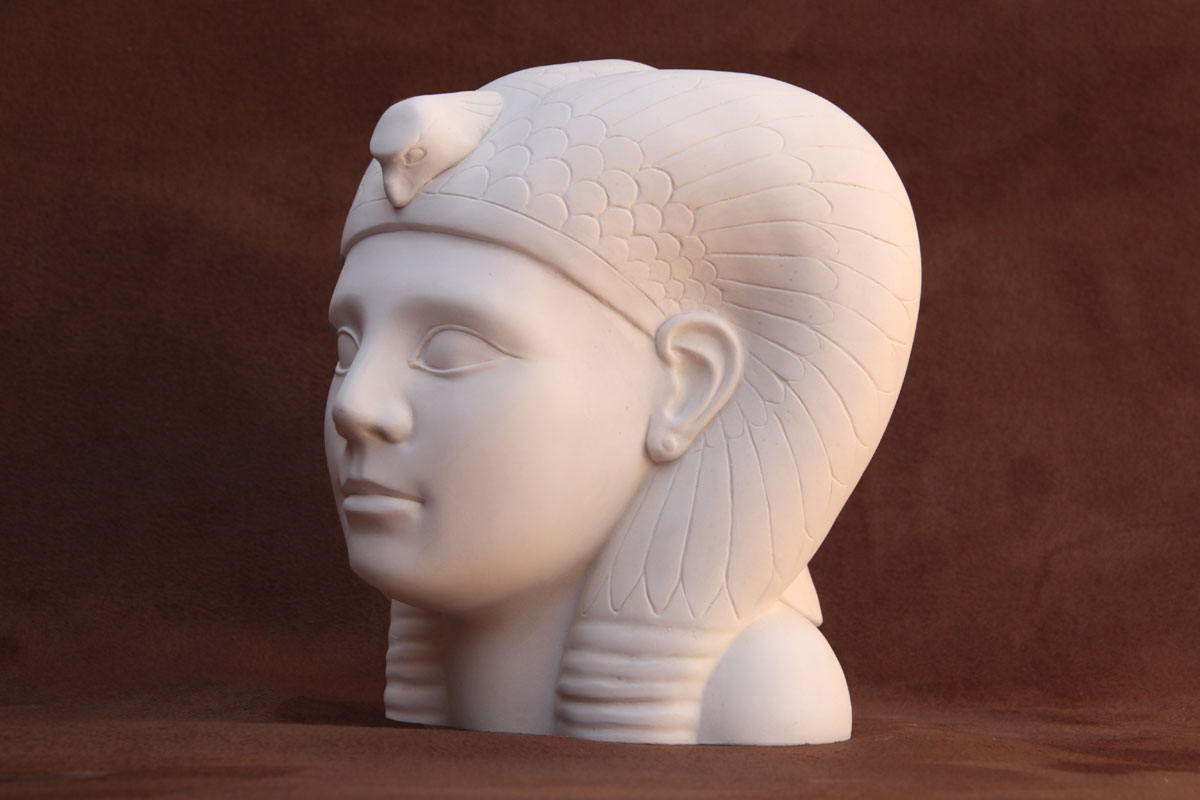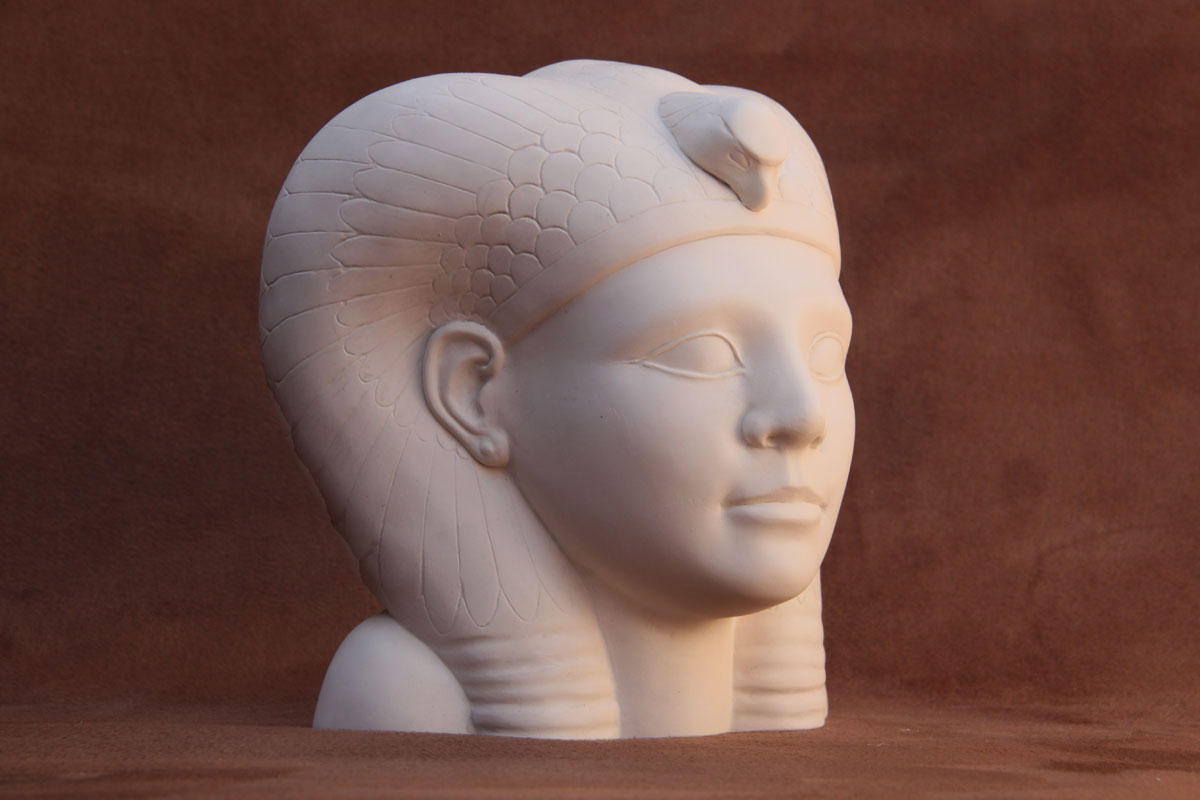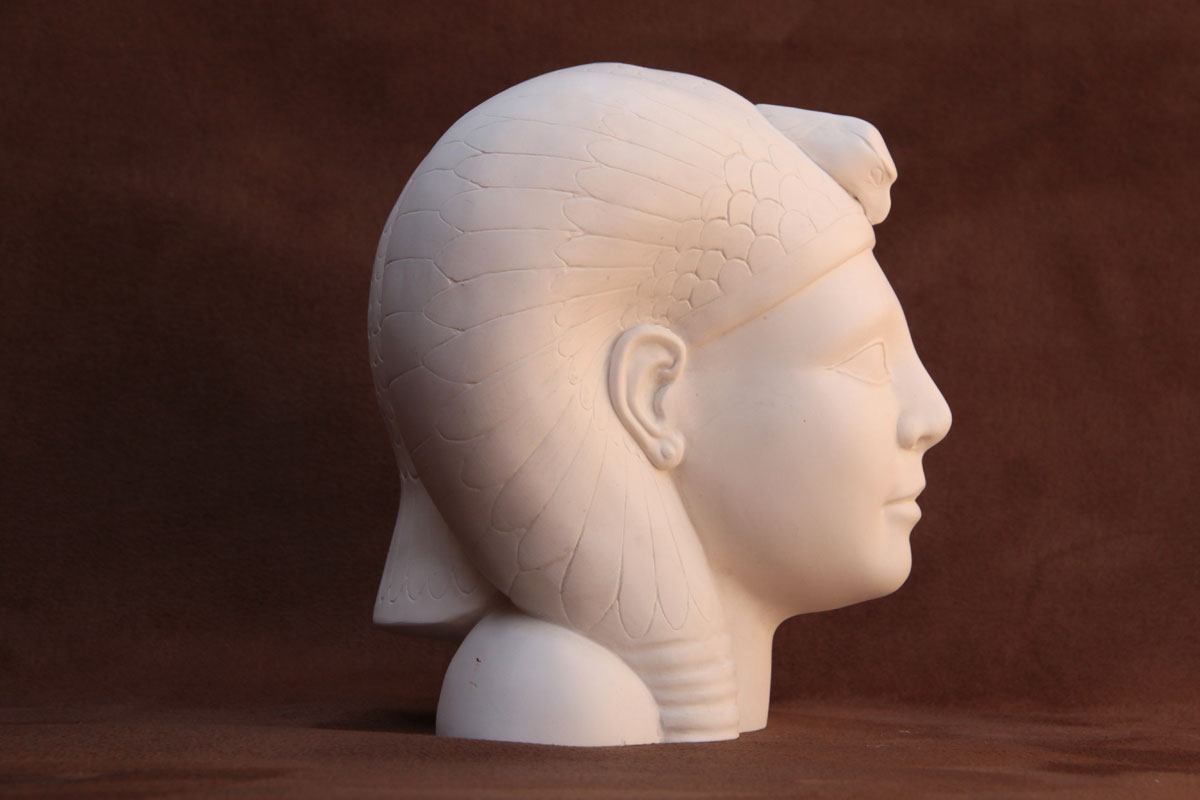
Egyptian Bookends Collection
Click on the image to enlarge.
Bast, Egyptian Cat Large (Single Black & Gold)
Sacred to the Ancient Egyptians, cats were the special attribute of the goddess Bast (Bastet) and were originally depicted as fiercely protective lions.
Sacred to the Ancient Egyptians, cats were the special attribute of the goddess Bast (Bastet) and were originally depicted as fiercely protective lions.
More Info
Gradually, this image softened and the goddess Bastet was often depicted as having the body of a woman and the head of a domestic cat. She was perceived as a gentle, protective goddess.
Bastet became a household goddess and a protector of women, children and domestic cats. She was also the goddess of sunrise, music, dance, pleasure, as well as family, fertility and birth.
Bastet was one of the daughters of the sun god, Ra. A great temple was built in her honour at Bubastis in the Delta.
Height 21cm
Bastet became a household goddess and a protector of women, children and domestic cats. She was also the goddess of sunrise, music, dance, pleasure, as well as family, fertility and birth.
Bastet was one of the daughters of the sun god, Ra. A great temple was built in her honour at Bubastis in the Delta.
Height 21cm
Click on the image to enlarge.
Mask of Tutankhamun
(Ornament or Bookend Single)
The 1922 discovery by Howard Carter and George Herbert, 5th Earl of Carnarvon of Tutankhamun's virtually intact tomb received worldwide press coverage.
(Ornament or Bookend Single)
The 1922 discovery by Howard Carter and George Herbert, 5th Earl of Carnarvon of Tutankhamun's virtually intact tomb received worldwide press coverage.
More Info
It sparked a renewed public interest in Ancient Egypt, for which Tutankhamun's burial mask remains the popular symbol.
Tutankhamun's tomb was the only burial chamber to be discovered dating from Egypt’s New Kingdom (c1550–1069 BC) to have been found substantially intact.
The contents provided an unequalled insight into royal funerary practices, art and craftsmanship of the period.
Height: 180mm
Width: 100mm
Depth: 70mm
Tutankhamun's tomb was the only burial chamber to be discovered dating from Egypt’s New Kingdom (c1550–1069 BC) to have been found substantially intact.
The contents provided an unequalled insight into royal funerary practices, art and craftsmanship of the period.
Height: 180mm
Width: 100mm
Depth: 70mm
Mask of Tutankhamun Bookends White (Set of 2)
The 1922 discovery by Howard Carter and George Herbert, 5th Earl of Carnarvon of Tutankhamun's virtually intact tomb received worldwide press coverage.
The 1922 discovery by Howard Carter and George Herbert, 5th Earl of Carnarvon of Tutankhamun's virtually intact tomb received worldwide press coverage.
More Info
It sparked a renewed public interest in Ancient Egypt, for which Tutankhamun's burial mask remains the popular symbol.
Tutankhamun's tomb was the only burial chamber to be discovered dating from Egypt’s New Kingdom (c1550–1069 BC) to have been found substantially intact.
The contents provided an unequalled insight into royal funerary practices, art and craftsmanship of the period.
Height 18cm
Tutankhamun's tomb was the only burial chamber to be discovered dating from Egypt’s New Kingdom (c1550–1069 BC) to have been found substantially intact.
The contents provided an unequalled insight into royal funerary practices, art and craftsmanship of the period.
Height 18cm
Click on the image to enlarge.
Rameses II the Great / Single Bookend White
Was the third Egyptian Pharaoh (reigned 1279 BC – 1213 BC) of the Nineteenth dynasty.
Was the third Egyptian Pharaoh (reigned 1279 BC – 1213 BC) of the Nineteenth dynasty.
More Info
He is often regarded as the greatest, most celebrated, and most powerful Pharaoh of the Egyptian Empire and successors and later Egyptians called him the "Great Ancestor." Rameses was aged 25 when he ascended the throne and ruled Egypt for 67 years.
When in his thirtieth year of ruling he was promoted to a living god, Rameses wanted the buildings to reflect his status. Among the most notable structures he created are those at the Great Temple of Abu Simbel, where Rameses sits next to his fellow gods Amun, Ra-Horakhty, and Ptah.
This exquisite sculpture is a replica of the seated Rameses statue which was at the door of the Temple. The original statue is located in the ancient Wawat (or the legendary Ybsambul) in Nubia, near the borders of Sudan.
The sculpture shows an idealised image of Rameses as a young man, with high cheek-bones and smooth skin. His eyebrows arch gently over wide, almond-shaped eyes. His nose is straight and well- defined and his full lips are set in a serene smile. Jutting below his chin is the rectangular false beard traditionally worn by royalty.
Rameses also wears the nemes or royal head-dress. The stone head-dress of the statue is surmounted by a diadem or headband in the shape of a uraeus - a rearing cobra and on top of his head Rameses wears a modus crown.
Height: 320mm
Width: 95mm
Depth: 140mm
When in his thirtieth year of ruling he was promoted to a living god, Rameses wanted the buildings to reflect his status. Among the most notable structures he created are those at the Great Temple of Abu Simbel, where Rameses sits next to his fellow gods Amun, Ra-Horakhty, and Ptah.
This exquisite sculpture is a replica of the seated Rameses statue which was at the door of the Temple. The original statue is located in the ancient Wawat (or the legendary Ybsambul) in Nubia, near the borders of Sudan.
The sculpture shows an idealised image of Rameses as a young man, with high cheek-bones and smooth skin. His eyebrows arch gently over wide, almond-shaped eyes. His nose is straight and well- defined and his full lips are set in a serene smile. Jutting below his chin is the rectangular false beard traditionally worn by royalty.
Rameses also wears the nemes or royal head-dress. The stone head-dress of the statue is surmounted by a diadem or headband in the shape of a uraeus - a rearing cobra and on top of his head Rameses wears a modus crown.
Height: 320mm
Width: 95mm
Depth: 140mm
Click on the image to enlarge.
Rameses II the Great
Bookends (Set of 2)
Was the third Egyptian Pharaoh (reigned 1279 BC – 1213 BC) of the Nineteenth dynasty.
Bookends (Set of 2)
Was the third Egyptian Pharaoh (reigned 1279 BC – 1213 BC) of the Nineteenth dynasty.
More Info
He is often regarded as the greatest, most celebrated, and most powerful Pharaoh of the Egyptian Empire and successors and later Egyptians called him the "Great Ancestor." Rameses was aged 25 when he ascended the throne and ruled Egypt for 67 years.
When in his thirtieth year of ruling he was promoted to a living god, Rameses wanted the buildings to reflect his status. Among the most notable structures he created are those at the Great Temple of Abu Simbel, where Rameses sits next to his fellow gods Amun, Ra-Horakhty, and Ptah.
This exquisite sculpture is a replica of the seated Rameses statue which was at the door of the Temple. The original statue is located in the ancient Wawat (or the legendary Ybsambul) in Nubia, near the borders of Sudan.
The sculpture shows an idealised image of Rameses as a young man, with high cheek-bones and smooth skin. His eyebrows arch gently over wide, almond-shaped eyes. His nose is straight and well- defined and his full lips are set in a serene smile. Jutting below his chin is the rectangular false beard traditionally worn by royalty.
Rameses also wears the nemes or royal head-dress. The stone head-dress of the statue is surmounted by a diadem or headband in the shape of a uraeus - a rearing cobra and on top of his head Rameses wears a modus crown.
Dimensions each:
Height: 320mm
Width: 95mm
Depth: 140mm
When in his thirtieth year of ruling he was promoted to a living god, Rameses wanted the buildings to reflect his status. Among the most notable structures he created are those at the Great Temple of Abu Simbel, where Rameses sits next to his fellow gods Amun, Ra-Horakhty, and Ptah.
This exquisite sculpture is a replica of the seated Rameses statue which was at the door of the Temple. The original statue is located in the ancient Wawat (or the legendary Ybsambul) in Nubia, near the borders of Sudan.
The sculpture shows an idealised image of Rameses as a young man, with high cheek-bones and smooth skin. His eyebrows arch gently over wide, almond-shaped eyes. His nose is straight and well- defined and his full lips are set in a serene smile. Jutting below his chin is the rectangular false beard traditionally worn by royalty.
Rameses also wears the nemes or royal head-dress. The stone head-dress of the statue is surmounted by a diadem or headband in the shape of a uraeus - a rearing cobra and on top of his head Rameses wears a modus crown.
Dimensions each:
Height: 320mm
Width: 95mm
Depth: 140mm
Egyptian Queen Bookends / Ornament (Set of 2)
This is a copy of an Egyptian Head sculpture. The original can be seen at the Burrell Collection in Glasgow, Scotland.
This is a copy of an Egyptian Head sculpture. The original can be seen at the Burrell Collection in Glasgow, Scotland.
More Info
Sir William Burrell (1861-1958) was a wealthy Glasgow ship owner and he and his wife, Constance, Lady Burrell gifted his collection of over 9,000 works of art to Glasgow in 1944.
Burrell established his collection of art and artefacts over many years. This Egyptian sculpture like many of his acquisitions was bought from a dealer on the antiquities market and therefore has no provenance history.
Although we have no provenance, the piece itself gives some clues as to its history. The original sculpture is black in colour, most likely made of black Basalt, a popular material of the period.
The subject of the sculpture wears a "Vulture Cap", an item synonymous with sovereignty in Ancient Egypt. In Egyptian mythology, vultures were symbols of femininity and maternal protection. The headdress, worn by the Queens of Ancient Egypt has associations with Nekhbet, the patron of the Pharaoh and later Mut, the maternal goddess.
Other features of the head are the scroll and Hathor wigs which were popularly worn by Queens in the late 18th Dynasty, which is around the same period the curators of The Burrell Collection date the piece, circa 1400 BC.
Height 20cm
Burrell established his collection of art and artefacts over many years. This Egyptian sculpture like many of his acquisitions was bought from a dealer on the antiquities market and therefore has no provenance history.
Although we have no provenance, the piece itself gives some clues as to its history. The original sculpture is black in colour, most likely made of black Basalt, a popular material of the period.
The subject of the sculpture wears a "Vulture Cap", an item synonymous with sovereignty in Ancient Egypt. In Egyptian mythology, vultures were symbols of femininity and maternal protection. The headdress, worn by the Queens of Ancient Egypt has associations with Nekhbet, the patron of the Pharaoh and later Mut, the maternal goddess.
Other features of the head are the scroll and Hathor wigs which were popularly worn by Queens in the late 18th Dynasty, which is around the same period the curators of The Burrell Collection date the piece, circa 1400 BC.
Height 20cm
Egyptian Bookends Collection
Click on the image to enlarge.
Bast, Egyptian Cat Large (Single Black & Gold)
Sacred to the Ancient Egyptians, cats were the special attribute of the goddess Bast (Bastet) and were originally depicted as fiercely protective lions.
Sacred to the Ancient Egyptians, cats were the special attribute of the goddess Bast (Bastet) and were originally depicted as fiercely protective lions.
More Info
Gradually, this image softened and the goddess Bastet was often depicted as having the body of a woman and the head of a domestic cat. She was perceived as a gentle, protective goddess.
Bastet became a household goddess and a protector of women, children and domestic cats. She was also the goddess of sunrise, music, dance, pleasure, as well as family, fertility and birth.
Bastet was one of the daughters of the sun god, Ra. A great temple was built in her honour at Bubastis in the Delta.
Height 21cm
Bastet became a household goddess and a protector of women, children and domestic cats. She was also the goddess of sunrise, music, dance, pleasure, as well as family, fertility and birth.
Bastet was one of the daughters of the sun god, Ra. A great temple was built in her honour at Bubastis in the Delta.
Height 21cm
Click on the image to enlarge.
Mask of Tutankhamun
(Ornament or Bookend Single)
The 1922 discovery by Howard Carter and George Herbert, 5th Earl of Carnarvon of Tutankhamun's virtually intact tomb received worldwide press coverage.
(Ornament or Bookend Single)
The 1922 discovery by Howard Carter and George Herbert, 5th Earl of Carnarvon of Tutankhamun's virtually intact tomb received worldwide press coverage.
More Info
It sparked a renewed public interest in Ancient Egypt, for which Tutankhamun's burial mask remains the popular symbol.
Tutankhamun's tomb was the only burial chamber to be discovered dating from Egypt’s New Kingdom (c1550–1069 BC) to have been found substantially intact.
The contents provided an unequalled insight into royal funerary practices, art and craftsmanship of the period.
Height: 180mm
Width: 100mm
Depth: 70mm
Tutankhamun's tomb was the only burial chamber to be discovered dating from Egypt’s New Kingdom (c1550–1069 BC) to have been found substantially intact.
The contents provided an unequalled insight into royal funerary practices, art and craftsmanship of the period.
Height: 180mm
Width: 100mm
Depth: 70mm
Mask of Tutankhamun Bookends White (Set of 2)
The 1922 discovery by Howard Carter and George Herbert, 5th Earl of Carnarvon of Tutankhamun's virtually intact tomb received worldwide press coverage.
The 1922 discovery by Howard Carter and George Herbert, 5th Earl of Carnarvon of Tutankhamun's virtually intact tomb received worldwide press coverage.
More Info
It sparked a renewed public interest in Ancient Egypt, for which Tutankhamun's burial mask remains the popular symbol.
Tutankhamun's tomb was the only burial chamber to be discovered dating from Egypt’s New Kingdom (c1550–1069 BC) to have been found substantially intact.
The contents provided an unequalled insight into royal funerary practices, art and craftsmanship of the period.
Height 18cm
Tutankhamun's tomb was the only burial chamber to be discovered dating from Egypt’s New Kingdom (c1550–1069 BC) to have been found substantially intact.
The contents provided an unequalled insight into royal funerary practices, art and craftsmanship of the period.
Height 18cm
Click on the image to enlarge.
Rameses II the Great / Single Bookend White
Was the third Egyptian Pharaoh (reigned 1279 BC – 1213 BC) of the Nineteenth dynasty.
Was the third Egyptian Pharaoh (reigned 1279 BC – 1213 BC) of the Nineteenth dynasty.
More Info
He is often regarded as the greatest, most celebrated, and most powerful Pharaoh of the Egyptian Empire and successors and later Egyptians called him the "Great Ancestor." Rameses was aged 25 when he ascended the throne and ruled Egypt for 67 years.
When in his thirtieth year of ruling he was promoted to a living god, Rameses wanted the buildings to reflect his status. Among the most notable structures he created are those at the Great Temple of Abu Simbel, where Rameses sits next to his fellow gods Amun, Ra-Horakhty, and Ptah.
This exquisite sculpture is a replica of the seated Rameses statue which was at the door of the Temple. The original statue is located in the ancient Wawat (or the legendary Ybsambul) in Nubia, near the borders of Sudan.
The sculpture shows an idealised image of Rameses as a young man, with high cheek-bones and smooth skin. His eyebrows arch gently over wide, almond-shaped eyes. His nose is straight and well- defined and his full lips are set in a serene smile. Jutting below his chin is the rectangular false beard traditionally worn by royalty.
Rameses also wears the nemes or royal head-dress. The stone head-dress of the statue is surmounted by a diadem or headband in the shape of a uraeus - a rearing cobra and on top of his head Rameses wears a modus crown.
Height: 320mm
Width: 95mm
Depth: 140mm
When in his thirtieth year of ruling he was promoted to a living god, Rameses wanted the buildings to reflect his status. Among the most notable structures he created are those at the Great Temple of Abu Simbel, where Rameses sits next to his fellow gods Amun, Ra-Horakhty, and Ptah.
This exquisite sculpture is a replica of the seated Rameses statue which was at the door of the Temple. The original statue is located in the ancient Wawat (or the legendary Ybsambul) in Nubia, near the borders of Sudan.
The sculpture shows an idealised image of Rameses as a young man, with high cheek-bones and smooth skin. His eyebrows arch gently over wide, almond-shaped eyes. His nose is straight and well- defined and his full lips are set in a serene smile. Jutting below his chin is the rectangular false beard traditionally worn by royalty.
Rameses also wears the nemes or royal head-dress. The stone head-dress of the statue is surmounted by a diadem or headband in the shape of a uraeus - a rearing cobra and on top of his head Rameses wears a modus crown.
Height: 320mm
Width: 95mm
Depth: 140mm
Click on the image to enlarge.
Rameses II the Great
Bookends (Set of 2)
Was the third Egyptian Pharaoh (reigned 1279 BC – 1213 BC) of the Nineteenth dynasty.
Bookends (Set of 2)
Was the third Egyptian Pharaoh (reigned 1279 BC – 1213 BC) of the Nineteenth dynasty.
More Info
He is often regarded as the greatest, most celebrated, and most powerful Pharaoh of the Egyptian Empire and successors and later Egyptians called him the "Great Ancestor." Rameses was aged 25 when he ascended the throne and ruled Egypt for 67 years.
When in his thirtieth year of ruling he was promoted to a living god, Rameses wanted the buildings to reflect his status. Among the most notable structures he created are those at the Great Temple of Abu Simbel, where Rameses sits next to his fellow gods Amun, Ra-Horakhty, and Ptah.
This exquisite sculpture is a replica of the seated Rameses statue which was at the door of the Temple. The original statue is located in the ancient Wawat (or the legendary Ybsambul) in Nubia, near the borders of Sudan.
The sculpture shows an idealised image of Rameses as a young man, with high cheek-bones and smooth skin. His eyebrows arch gently over wide, almond-shaped eyes. His nose is straight and well- defined and his full lips are set in a serene smile. Jutting below his chin is the rectangular false beard traditionally worn by royalty.
Rameses also wears the nemes or royal head-dress. The stone head-dress of the statue is surmounted by a diadem or headband in the shape of a uraeus - a rearing cobra and on top of his head Rameses wears a modus crown.
Dimensions each:
Height: 320mm
Width: 95mm
Depth: 140mm
When in his thirtieth year of ruling he was promoted to a living god, Rameses wanted the buildings to reflect his status. Among the most notable structures he created are those at the Great Temple of Abu Simbel, where Rameses sits next to his fellow gods Amun, Ra-Horakhty, and Ptah.
This exquisite sculpture is a replica of the seated Rameses statue which was at the door of the Temple. The original statue is located in the ancient Wawat (or the legendary Ybsambul) in Nubia, near the borders of Sudan.
The sculpture shows an idealised image of Rameses as a young man, with high cheek-bones and smooth skin. His eyebrows arch gently over wide, almond-shaped eyes. His nose is straight and well- defined and his full lips are set in a serene smile. Jutting below his chin is the rectangular false beard traditionally worn by royalty.
Rameses also wears the nemes or royal head-dress. The stone head-dress of the statue is surmounted by a diadem or headband in the shape of a uraeus - a rearing cobra and on top of his head Rameses wears a modus crown.
Dimensions each:
Height: 320mm
Width: 95mm
Depth: 140mm
Egyptian Queen Bookends / Ornament (Set of 2)
This is a copy of an Egyptian Head sculpture. The original can be seen at the Burrell Collection in Glasgow, Scotland.
This is a copy of an Egyptian Head sculpture. The original can be seen at the Burrell Collection in Glasgow, Scotland.
More Info
Sir William Burrell (1861-1958) was a wealthy Glasgow ship owner and he and his wife, Constance, Lady Burrell gifted his collection of over 9,000 works of art to Glasgow in 1944.
Burrell established his collection of art and artefacts over many years. This Egyptian sculpture like many of his acquisitions was bought from a dealer on the antiquities market and therefore has no provenance history.
Although we have no provenance, the piece itself gives some clues as to its history. The original sculpture is black in colour, most likely made of black Basalt, a popular material of the period.
The subject of the sculpture wears a "Vulture Cap", an item synonymous with sovereignty in Ancient Egypt. In Egyptian mythology, vultures were symbols of femininity and maternal protection. The headdress, worn by the Queens of Ancient Egypt has associations with Nekhbet, the patron of the Pharaoh and later Mut, the maternal goddess.
Other features of the head are the scroll and Hathor wigs which were popularly worn by Queens in the late 18th Dynasty, which is around the same period the curators of The Burrell Collection date the piece, circa 1400 BC.
Height 20cm
Burrell established his collection of art and artefacts over many years. This Egyptian sculpture like many of his acquisitions was bought from a dealer on the antiquities market and therefore has no provenance history.
Although we have no provenance, the piece itself gives some clues as to its history. The original sculpture is black in colour, most likely made of black Basalt, a popular material of the period.
The subject of the sculpture wears a "Vulture Cap", an item synonymous with sovereignty in Ancient Egypt. In Egyptian mythology, vultures were symbols of femininity and maternal protection. The headdress, worn by the Queens of Ancient Egypt has associations with Nekhbet, the patron of the Pharaoh and later Mut, the maternal goddess.
Other features of the head are the scroll and Hathor wigs which were popularly worn by Queens in the late 18th Dynasty, which is around the same period the curators of The Burrell Collection date the piece, circa 1400 BC.
Height 20cm
